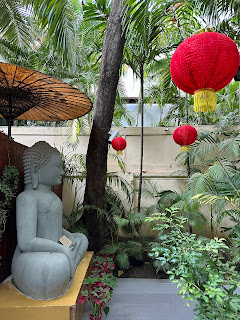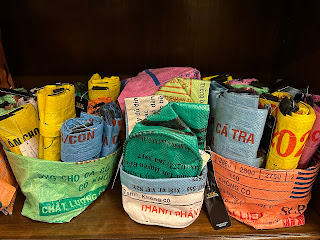 |
| A gilded reclining Buddha in Phnom Penh |
What kind of hotel does $97 a night buy in the U.S. or Europe? In Phnom Penh, Cambodia, it buys a comfortable suite at the Pavilion Hotel, with gardens, two pools, a spa and outdoor restaurant serving $6 cocktails and an unlimited breakfast on the outdoor terrace.
 |
| The Pavilion Hotel, five-star service at two-star prices |
An isolated and pretentious Western-style resort, you say? Hardly the case, given our next-door neighbors - street food vendors grilling on the side walk, sugar cane juice sellers and Buddhist monks living in a monastery where a giant Buddha reclines in a gilded temple.
 |
| A family sets up for the evening dinner rush |
When most Americans think of traveling overseas, they think of Europe or Australia. Few think of Southeast Asia, and when they do, it’s the beaches of Thailand or Vietnam that come to mind. Few consider Cambodia, a country bombed by the U.S. during the Vietnam war, and ravaged in the late 1970s by Pol Pot and his Communist Khmer Rouge regime.
While Siem Reap is well-known for its ancient Angkor Wat temples, Phnom Penh is the surprise city. Abandoned when Pol Pot forced city dwellers back to their home villages in the countryside, it‘s now alive with a mixture of modern and French colonial architecture; street food carts and rooftop bars; outdoor markets and modern malls; and massive monasteries where monks in saffron robes welcome visitors.
 |
| Bea Tem, a Buddhist monk at our neighborhood temple |
 |
| Morning Glory for sale in a street market |
With major sightseeing out of the way on a previous trip, we found various ways to explore the street life, either on foot or by taking Grab taxis which work like Uber does in the U.S. Most rides are $1-$4 at most, more comfortable and often less expensive than Tuk-Tuks, the open-air motorcycles, we use when we were here 19 years ago.
Especially fun are a variety of three or four-hour tours organized by eager, English-speaking young people. This is where the Tuk-Tuks do come in handy. Because of the 95 degree heat, signing up for a “walking tour” means going with a guide in a Tuk-Tuk with a driver who waits at each stop.
 |
| Neara explains the many types of herbs grown in Cambodia |
The delightful Yim Neara, 30, was our guide for an early-morning breakfast tour by Turk-Tuk, organized by Portland, Oregon Lost Plate Tours. She arrived at our hotel at 8:30 a.m. and by 9 a.m., three of us were sampling steaming bowls of a pork and vegetable noodle soup at a popular street stall where the owner shows up at 4 a.m. to start the broth.
 |
| Key Teay is a popular breakfast food in Cambodia |
Most Cambodians go to a stall like this for breakfast rather than prepare the time-consuming dishes at home. The soup is eaten with a spoon and chopsticks, for picking up the thin rice noodles, and accompanied by shot glass-sized cups of coffee laced with sweetened condensed milk.
 |
| Banh Chao for breakfast |
Our next “walking tour” by Tuk-Tuk was an architectural tour led by Hun Sokagna, 30, a university graduate and freelance architect specializing in urban preservation. She is a member of Architecture Cambodia, a non-profit organization of architects and students promoting urban heritage in Cambodia. Customized tours can be organized on request for around $20 a person. Free walking tour maps are available on the website of Khmer Architecture Tours.
 |
| Our guide, Sokagna, going over our plan to see local architecture |
 |
| The former Grand Hotel, now part casino, part run-down apartments |
The facade on this side of the old hotel is run down and in need of a paint job. The interior is run down as well although some of the original tile work remains. On the other side of the building is a sleek entrance to a modern Chinese-owned casino and a wine bar.
 |
| YEK Hong Tang |
YEK Hong Tang, above, is the executive director and also the designer of many items, including these new messenger bags made with reused nylon netting traditionally used for hammocks or mosquito nets.






Carol, I love and appreciate your focus on responsible and sustainable tourism in places where tourist dollars can easily harm vulnerable people and wreak havoc on local culture. Thank you for opening the door to countries many of us might otherwise hesitate to visit.
ReplyDeleteCambodia is a marvelous place to visit. We haven't stayed in Phnom Penh but have been to Siem Reap twice...staying at Jaya House.... small hotel
ReplyDelete